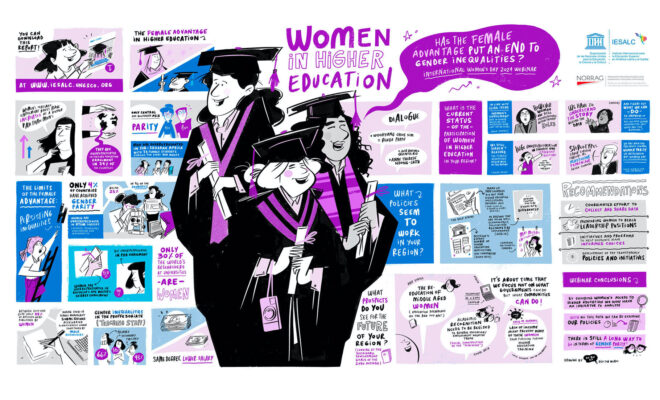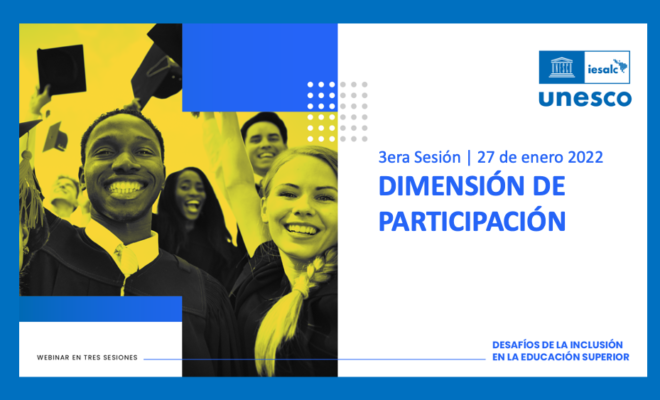Has the female advantage put an end to gender inequalities? A report and a debate seek to provide an answer

To commemorate the International Women’s Day on March 8, the UNESCO International Institute for Higher Education in Latin America and the Caribbean (IESALC) and the Network for international policies and cooperation in education and training (NORRAG) hosted the webinar entitled Women in higher education: has the female advantage put an end to gender inequalities?
Experts in higher education from diverse regions of the world met virtually for a discussion on the challenges to overcome gender inequality, in the frame of the launching of the eponymous report. “The IESALC report is a call for action. An important one; it´s a matter of human rights (…) I would like to challenge education actors to assure the report and take strong actions in gender equalities in education,” said UNESCO Assistant Director-General for Education Stefania Giannini, in her opening remarks.
Moira Faul, NORRAG Executive Director, followed sharing her personal story when her grandmother stood up to her grandfather to ensure their daughter’s education, high school, and training school. “My grandmother ensured that my mother got her education … and my mother then supported me to be the first person and the first woman in my family to even go on to postgraduate studies,” said Faul.
After this introduction, Daniele Vieira, Research Coordinator, summarized the objectives of the IESALC report, centered on describing and identifying the situation of women´s participation in higher education and highlighting the areas with persisting gender inequalities to provide policy recommendations.
“The report highlights that, regardless of the encouraging statistics on women’s access to higher education, there are obstacles when seeking to occupy key academic positions at universities, participate in relevant research and assume leadership roles”, said Vieira.
According to the document, all the regions of the world have seen an increase in female enrolment in tertiary education, which tripled globally between 1995 and 2018 at a higher rate than male enrolment, showing overrepresentation in 74% of countries with data, except for Central and Southern Asia, where there is parity, and sub-Saharan Africa, where men are overrepresented, with 73 female students enrolled for every 100 males.
Nevertheless, there are limits within the female advantage: there are wage gaps and women are underrepresented in STEM careers, with less than 25% of female participation in 2/3 of countries. Also, Ph.D. female enrolment has 44% against 53% of presence in bachelor and master’s degree enrolment. Other data reflects underrepresentation in research performance and in tertiary teaching, as well as in senior management positions.
Global open Dialogue
Based on the Report launched, the webinar proposed an open dialogue on the current status of women’s participation in HE in diverse regions of the world to find out the current situation in the different regions and how are inequalities being addressed. Woohyang Chloe Sim, Researcher at the Waseda University Faculty of Education and Integrated Arts and Sciences, explained the “education phenomena” in six Arab Gulf States, in line with the global trend showed in the Report. For example, since 2000, Qatar, Kuwait, and the UAE had a female student enrollment rate at 70%, with female faculty in the case of Qatar of 50%. “Arab women have crossed boundaries in education even earlier than in other industries (…) but the shadow on HE has not completely vanished: within women’s universities and women campuses women are present at senior level, in faculty and decision-making bodies, but the government and administrative leaders remain mostly male.”
Ann Therese Ndong-Jatta, Director of the Multi-Sectoral Office in Nairobi for Eastern Africa, stressed that, as stated in the Report, there are gender inequalities in Africa with women underrepresentation in HE, a data that needs to be analyzed to understand the story behind inequalities, their persistence, and where to make improvements. “We have to tackle issues of role stereotyping, of sensitization. In terms of policies and budget allocation, more needs to be done, because the change is not impacting on the quality of life, on development, and the female gender continues to be at disadvantage.”
Rekha Pappu, Professor and Chairperson at the Azim Premji School of Education at the Tata Institute of Social Sciences, with expertise in South Asia, said that regardless of policies implemented by governments, there are cultural factors of influence for female underrepresentation in the region, which accounts for 24% with great disparities among countries. “But what the country level statistics probably masks is that there is underrepresentation in HE for girls from marginalized backgrounds, cast in different disciplines and underrepresented in STEM subjects, without statistics on the completion figures, and underrepresentation in faculty and in leadership positions.”
According to José Antonio Quinteiro, Programs Coordinator at UNESCO IESALC with expertise in Latin America and the Caribbean, the region is making progress towards gender parity in research, but women still lag behind men in the number of publications and citations. “The region ranks better in comparison with other geographic blocks with 55% of enrollment that decreases in higher hierarchical levels within the Academia. For example, with 36% of female professors and only 18% of female rectors.” In terms of research, in Mexico, in every 333 articles authored by men, only 33 were written by women, as reported by Elsevier for 2014-2018. “We need much more women in science, in STEM fields, and in senior levels within the Academia.”
Regional policies for change
As part of the ongoing dialogue, the panelists shared different policies that have worked in their regions of expertise. In the case of the Gulf States, they are developing to secure human capital with higher education placing a crucial role in economic development, so they have encouraged the younger students to pursue HE, investing and subsidizing higher education at all levels, with scholarships, increasing women’s enrolment and participation.
In South Asia, the economic support from States plays an important role in the enrollment and completion of higher education, as per the provision of school and elementary education, contributing to having more girls going into colleges and universities. Other policies include female scholarships, cultural factors associated with prestige, and the adoption of laws to prevent sexual harassment.
At a continental level, the African Union has focused on HE which gave rise to HE councils, promoting quality assurance; recognition of studies, with the UNESCO Convention which has given a boost in Africa. But the necessary budgets to implement policies are very low.
In Latin America, most policies are mainly focused on campaigns to attract more girls into scientific areas in secondary school, with the adoption of the SAGA methodology in Argentina, and “Más Mujeres in Ciencia” (More women in Science), in Uruguay, besides bootcamps and coding club experiences.
To close the event Carolyn Medel–Anonuevo, Head of the Education Unit of the UNESCO Regional Office for Southern Africa, remarked on the importance of policies on sexual harassment and gender-based violence, which paves the way for women to participate and go beyond access: “the gender index is very instrumental in making understand that women are getting the number in terms of access, but there is a long way to go in terms of contributions to the sustainable development goals.”
At the closure, Francesc Pedró, director of UNESCO IESALC, invited the audience to join NORRAG and announced the continuity of this alliance for the next commemoration of International Women’s Day.
Download the report Report Women in higher education: has the female advantage put an end to gender inequalities?
Related news UNESCO IESALC Report asserts that gender inequality in higher education remains a universal issue.
RELATED ITEMS








